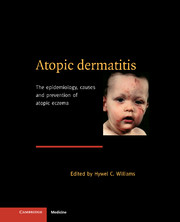Book contents
- Frontmatter
- Contents
- List of contributors
- Foreword Georg Rajka
- Preface
- Part I The nature of the problem
- Part II Descriptive studies which indicate the size of the problem
- 5 Geographical studies of atopic dermatitis
- 6 The morbidity and cost of atopic dermatitis
- 7 Is the prevalence of atopic dermatitis increasing?
- Part III Analytical studies which point to causes of atopic dermatitis
- Part IV Intervention studies
- Part V Lessons from other fields of research
- Part VI Conclusions
- Additional information
- Index
- Plate section
6 - The morbidity and cost of atopic dermatitis
from Part II - Descriptive studies which indicate the size of the problem
Published online by Cambridge University Press: 17 August 2009
- Frontmatter
- Contents
- List of contributors
- Foreword Georg Rajka
- Preface
- Part I The nature of the problem
- Part II Descriptive studies which indicate the size of the problem
- 5 Geographical studies of atopic dermatitis
- 6 The morbidity and cost of atopic dermatitis
- 7 Is the prevalence of atopic dermatitis increasing?
- Part III Analytical studies which point to causes of atopic dermatitis
- Part IV Intervention studies
- Part V Lessons from other fields of research
- Part VI Conclusions
- Additional information
- Index
- Plate section
Summary
Age-specific prevalence
In contrast with other atopic diseases, there are few good population-based epidemiological studies of atopic dermatitis (AD). It is hard to decipher any prevalence trend in published studies because of the various measures of frequency and different age groups. Most have avoided the inherent sampling difficulties of studying entire populations by concentrating on schoolchildren who are accessible and have a high prevalence of AD. The lack of firm diagnostic criteria has usually been glossed over and data have been collected from postal questionnaires health visitor and general practitioner records and, rarely, by dermatologist examination.
It is acknowledged that the prevalence of AD is rising (Williams, 1992) and that there are regional variations (Golding & Peters, 1987). The true prevalence today must be determined from recent reports from representative populations.
The prevalence of atopic dermatitis in young schoolchildren
The results of prevalence estimates in some recent studies of young schoolchildren are discussed in Chapter 5 and listed in Table 5.1. Those which have included a skin examination are shown in Table 6.1.
Many of the studies listed have estimated lifetime prevalence. But memory becomes less reliable with passing time and lifetime prevalences, based on parental recall, will be subject to variation even if diagnostic accuracy can be assumed. Furthermore, the lifetime prevalence gives no information about age-specific rates: it does not tell us how many had only infantile eczema, and how many were still suffering from active eczema.
- Type
- Chapter
- Information
- Atopic DermatitisThe Epidemiology, Causes and Prevention of Atopic Eczema, pp. 85 - 95Publisher: Cambridge University PressPrint publication year: 2000
- 13
- Cited by

